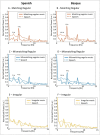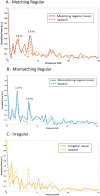Temporal Structure of Music Improves the Cortical Encoding of Speech
- PMID: 40129256
- PMCID: PMC11933723
- DOI: 10.1002/hbm.70199
Temporal Structure of Music Improves the Cortical Encoding of Speech
Abstract
Long- and short-term musical training has been proposed to improve the efficiency of cortical tracking of speech, which refers to the synchronization of brain oscillations and the acoustic temporal structure of external stimuli. Here, we study how musical sequences with different rhythm structures can guide the temporal dynamics of auditory oscillations synchronized with the speech envelope. For this purpose, we investigated the effects of prior exposure to rhythmically structured musical sequences on cortical tracking of speech in Basque-Spanish bilingual adults (Experiment 1; N = 33, 22 female, Mean age = 25 years). We presented participants with sentences in Basque and Spanish preceded by musical sequences that differed in their rhythmical structure. The rhythmical structure of the musical sequences was created to (1) reflect and match the syllabic structure of the sentences, (2) reflect a regular rhythm but not match the syllabic structure of the sentences, and (3) follow an irregular rhythm. Participants' brain responses were recorded using electroencephalography, and speech-brain coherence in the delta and theta bands was calculated. Results showed stronger speech-brain coherence in the delta band in the first condition, but only for Spanish stimuli. A follow-up experiment including a subset of the initial sample (Experiment 2; N = 20) was conducted to investigate whether language-specific stimuli properties influenced the Basque results. Similar to Experiment 1, we found stronger speech-brain coherence in the delta and theta bands when the sentences were preceded by musical sequences that matched their syllabic structure. These results suggest that not only the regularity in music is crucial for influencing cortical tracking of speech, but so is adjusting this regularity to optimally reflect the rhythmic characteristics of listeners' native language(s). Despite finding some language-specific differences across frequencies, we showed that rhythm, inherent in musical signals, guides the adaptation of brain oscillations, by adapting the temporal dynamics of the oscillatory activity to the rhythmic scaffolding of the musical signal.
Keywords: cortical tracking; musical exposure; oscillations; rhythm.
© 2025 The Author(s). Human Brain Mapping published by Wiley Periodicals LLC.
Conflict of interest statement
The authors declare no conflicts of interest.
Figures






Similar articles
-
Cortical tracking of rhythm in music and speech.Neuroimage. 2019 Jan 15;185:96-101. doi: 10.1016/j.neuroimage.2018.10.037. Epub 2018 Oct 15. Neuroimage. 2019. PMID: 30336253
-
The Impact of Selective Attention and Musical Training on the Cortical Speech Tracking in the Delta and Theta Frequency Bands.J Cogn Neurosci. 2025 Feb 1;37(2):464-481. doi: 10.1162/jocn_a_02275. J Cogn Neurosci. 2025. PMID: 39509103
-
One Way or Another: Cortical Language Areas Flexibly Adapt Processing Strategies to Perceptual And Contextual Properties of Speech.Cereb Cortex. 2021 Jul 29;31(9):4092-4103. doi: 10.1093/cercor/bhab071. Cereb Cortex. 2021. PMID: 33825884
-
Anatomically distinct cortical tracking of music and speech by slow (1-8Hz) and fast (70-120Hz) oscillatory activity.PLoS One. 2025 May 8;20(5):e0320519. doi: 10.1371/journal.pone.0320519. eCollection 2025. PLoS One. 2025. PMID: 40341725 Free PMC article.
-
Music as a scaffold for listening to speech: Better neural phase-locking to song than speech.Neuroimage. 2020 Jul 1;214:116767. doi: 10.1016/j.neuroimage.2020.116767. Epub 2020 Mar 23. Neuroimage. 2020. PMID: 32217165
References
-
- Amarauna . 2025. El Acento en Euskera. https://www.amarauna.euskadi.eus/gl/recurso/el‐acento‐en‐euskera/0e48a23....
-
- Aurrekoetxea, G. , Gaminde I., and Iglesias A.. 2013. “Prosodic Variation in the Basque Language: Stress Areas.” In Current Approaches to Limits and Areas in Dialectology, edited by Carrilho E., Magro C., Álvarez X., 247–265. Cambridge Scholars Publishing.
-
- Bates, D. M. 2018. lme4: Mixed‐Effects Modeling With R.
-
- Besson, M. , Barbaroux M., and Dittinger E.. 2017. “Music in the Brain: Music and Language Processing.” In The Routledge Companion to Music Cognition, edited by Ashley R. and Timmers R., 37–48. Routledge.
MeSH terms
Grants and funding
- PCI2022-135031-2/Ministerio de Ciencia, Innovación y Universidades
- PDC2022-133917-I00/Ministerio de Ciencia, Innovación y Universidades
- PID2022-136991NB-I00/Ministerio de Ciencia, Innovación y Universidades
- PRE2019-087623/Ministerio de Ciencia, Innovación y Universidades
- RTI2018-096311-B-I0/Ministerio de Ciencia, Innovación y Universidades
LinkOut - more resources
Full Text Sources

